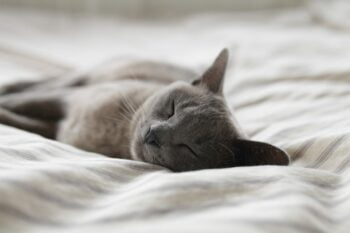The saying “fighting like cats and dogs” had to come from somewhere. But in Janis Cook’s experience, the phrase was far from reality. When she brought a service dog into the household that her cat had ruled for years, the Annandale, Virginia, pet owner was pleasantly surprised to see that the dog and cat actually got along well.
“The cat was very cautious for a while,” says Cook. “I made sure that the cat could jump away and escape. And the dog was very well trained. There was no problem at all. It just wasn’t an issue.”
Success, indeed, can happen. How well they get along together will depend on your pet’s personality, socialization, and how you prepare it for the addition of a Snoopy or Snowball, say animal behavior experts. Here are some tips on what to consider about your feline before adding a mutt to your hut, as well as advice on how to maintain household harmony if you’re set on living with both cats and dogs.
A Tale of Two Different Species
The first step to making the perfect match is to understand and respect the behaviors that make cats and dogs unique. Dogs are pack animals and like to be around humans. Cats can also bond with their owners, but they tend to be more territorial in your home. Dogs like to play chase; cats may view the game as a threat. But, aside from generalizations, most dogs and cats seem to have their own unique dispositions. “There are dogs who get on well with cats and cats who get along well with dogs,” says Dr. Nicholas Dodman, DVM, director of the animal behavior clinic at Tufts University’s Cummings School of Veterinary Medicine and author of Dogs Behaving Badly and The Cat Who Cried for Help (Bantam). “But there is no guarantee of success.”
Know Your Pet and its Background
One way to gauge whether a cat and dog will live in peace is if they have been raised with the other species. The attitudes of cats and dogs toward each other crystallize during their early development in the first few months of life, Dodman says. “Dogs raised in a household with cats are accustomed to them and may see them as they do a piece of furniture,” Dodman says. Some questions to ask about your cat: Was it raised in a family that had dogs? Are dogs completely alien to it? Cats have, on occasion, caused dogs serious harm, such as scratching the cornea of a dog’s eye with their claws. For pets rescued or adopted at an older age, the questions about background may never be answered. Another key factor is a dog’s breed. Dodman recounts how a graduate student adopted a pit bull and brought it into a home with four cats. “They all got along well for a few days,” he says. “But one cat may have darted or moved the wrong way and woke the sleeping predatory giant.” The dog wound up killing the cats.
Introducing a New Pet in Your Home
Focusing on less aggressive breeds, many cat owners have added pet dogs into their household with few problems. Dodman recommends taking the following steps to help ease the transition and to test whether or not this will be a happy marriage:
- Have a friend come over with a dog and see how your cat reacts. You may see a range of reactions from indifference to full-blown feline affective defense response — an arched back like a Halloween cat. Pay attention to those cues.
- Keep them in opposite parts of the house at first and gradually increase exposure. In particular, feed them separately, because both cats and dogs can get territorial around the food bowl.
- Introduce them under extremely pleasant circumstances in which you are petting the animals and talking sweetly. Make sure there are no other distractions, such as strangers, children or loud noises.
- Start by introducing them on opposite sides of a door, or while both are in carriers, so they can smell the other animal and so you can see a reaction. The next time, crack that door open or use a screen door.
Quite possibly, your pets will live in peace like Cook’s. “They just learned to get along,” she says. “The cat would play with the dog’s tail and she’d just let her.”







